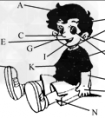单词拼写。根据首字母及汉语提示,完成下列单词的拼写,使句意明确,语言通顺. 1. He had got a bad ________(发烧) 2. I taught myself _________ _________ __________-八年级英语
37.fall ill=be i11 生病,患病
38.take sb. to a hospital 把某人送到医院
39.rain heavily 下大雨
40.on the road 在公路上
41.not know what to do 不知道该做什么
42.just then 正在那时
43.come up 走进,上来
44.in front of 在……前面
45.thank sb. again and again 反复感谢某人
46.drive away (汽车)离开
run away 跑开
take away 拿走
47.right away 立刻
48.right now 此刻,刚才,现在
49.get home 到家 get there 到达哪儿 get here 到达这儿
50. yesterday morning 昨天晚上
51.leave the hospital 离开医院
52.no buses=not any buses 没有车
53.say to sb.对某人说 say to oneself 自言自语
54.fall off 跌落
55.need to get up early 需要早起床
56.hurt my arm 胳膊受伤
57.What's wrong with you?=What's the matter with you? 你怎么了?
58.do one's homework on the computer 在电脑上做作业
59.have four English lessons 上四节英语课
60.once a week 一周一次 twice a year 一年两次 three times a month 一个月三次
61.do more listening and speaking 做大量的听说练习
do some cleaning 扫除
do some washing 洗衣服
do some shopping 购物
62.make good progress in English 在英语方面取得很大进步
63.help a lot in our studies 在学习上给子很大帮助
64.teach sb. English 教某人英语
65.get to school 到达学校
66.give sb.lessons 给某人上课
67.ask sb.to do sth.要求某人做某事
ask sb.not to do sth.要求某人不要做某事
68.let sb. do sth.让某人做某事
1et sb. not do sth.让某人不要做某事
69.not……until 直到……才
70.make one's lessons interesting 使某人的课上的很有趣
71.tell sb. how to do sth.告诉某人怎样做某事
72.try to learn new things be oneself 设法靠自己学一些新的知识
73.want to be a history teacher 想成为一名历史老师
74.grow up 长大
75.in future 在将来
76.computer room (电脑)机房
77.language lab 语言室
78.finish middle school 中学毕业
79.want to become (be) a designer 想成为一名设计家
80.wish to be doctor 希望成为一名医生
81.an American boy 一个美国男孩儿
82.study in a high school 在高中学习
83.in Grade Eight 在八年级
84.finish primary school 小学毕业
85.start school at the age of seven
=begin to school when I was seven 七岁开始上学
86.move to Washington with his family 和他全家搬到华盛顿
87.be interested in 对……感兴趣
88.want to become a doctor of Chinese medicine 想成为一名中医
89.come here to learn Chinese 来这儿学习中文
90.a nice school 一所好的学校
91.instead of 代替
92.in many ways 在许多方面
93.be different from 与……不同
94.by the way 顺便说
95.come back home 回家
96.be sorry for 为…难过,遗憾
97.feel sorry for 为…难过,遗憾
98.burn away 燃烧没了
99.open the door 开门
100.take sb. in one's arms 拥抱某人
101.have some medicine 吃药
102.have a football match 进行一场足球比赛
103.have a meeting 开会
104.walk back 向后走
105.give sth. back to sb. 把某物还给某人
106. work through the night 通宵工作
107.get through the examinations=pass the exam 通过考试
108.happen to 发生
l09.knock at the door 敲门
110.want to do sth. 想做…
111.fall down 掉下来
112.begin to do sth. 开始做…
113.have some tea 喝茶
114.have sports 进行体育锻炼
115.have a bad coId 得了重感冒
116.have a good time 玩的很高兴
117.keep back 向后退
118.so…that 如此…以至于…
考点名称:分词
- 分词:
就是具有动词及形容词二者特征的词;尤指以-ing或-ed,-d,-t,-en或-n结尾的英语动词性形容词,具有形容词功能,同时又表现各种动词性特点,
如时态,语态、带状语性修饰语的性能及带宾语的性能。
分词分为现在分词和过去分词两种,是一种非谓语动词形式。
现在分词和过去分词主要差别在于:
现在分词表示"主动和进行",过去分词表示"被动和完成"(不及物动词的过去分词不表示被动,只表示完成)。
分词可以有自己的状语、宾语或逻辑主语等。 现在分词构成形式:
①一般在动词原形末尾加ing,如do→doing、sing→singing、comfort→comforting
②以不发音的e、ue结尾的动词,先去e,再加ing,如dance→dancing、hike→hiking、write→writing、make→ making,take→taking
③以ee、oe、ye结尾的动词加ing,如see→seeing、toe→toeing、dye→dyeing
④以重读闭音节结尾的动词,并且末尾只有一个辅音字母,应双写这一字母,再加ing,如cut→cutting、swim→swimming
注:结尾是x则不必双写,如relax→relaxing
⑤以ie结尾的动词,要把ie变成y再加ing,如die→dying,lie→lying.
⑥以ic结尾的动词,要把ic变成ick再加ing,如picnic→picnicking,traffic→trafficking过去分词构成形式:
1.规则动词:规则动词的过去分词的构成规则与规则动词的过去式的构成规则相同。四点变化规则:
(1)、一般动词,在词尾直接加“ ed ”。(然而要注意的是,过去分词并不是过去式)
work---worked---worked , visit---visited---visited
(2)、以不发音的“ e ” 结尾的动词,只在词尾加“ d ”。
live---lived---lived
(3)、以“辅音字母 + y ”结尾的动词,将 "y" 变为 "i" ,再加“ ed ”。
study---studied---studied,cry---cried---cried,try---tried---tried,fry---fried---fried.[1]
(4)、重读闭音节结尾,末尾只有一个辅音字母,先双写该辅音字母,再加“ ed ”。
stop---stopped---stopped , drop---dropped--dropped
(5)、以ic结尾的动词,要把ic变成ick再加ed,
picnic→picnicked ,traffic→trafficked
2 、不规则动词:见不规则动词表分词用法:
1、分词作状语
分词在句子中作状语,可以表示时间、条件、原因、结果、让步、伴随等。
分词(短语)作状语时,其逻辑主语应与句中主语相一致。
当现在分词表示的动作发 生在谓语动词之前时, 则用现在分词的完成式,且所表示动作与谓语动作同时发生, 则用现在分词的一般式。
完成或被动关系用过去分词。
①现在分词:
The students went out of the classroom, laughing and talking.
②过去分词:
Accompanied by his friend, he went to the railway station.
Given better attention, the plants could grow better.
2、“while ( when, once, until, if , though等连词)+分词”结构
现在分词或过去分词作状语时,有时可以在分词前加while,when, once, although, until, if等连词。
①现在分词:
When leaving the airport, she waved again and again to us.
While waiting for the train, I had a long talk with my sister about her work……
②过去分词:
Once recovered, he threw himself into his work and made every effort to do it well.
Although working very hard, he failed to pass the final exam. If translated word by word, the passage will be difficult to understand.
3、分词作定语
分词作定语时,单个的分词通常放在被修饰的名词之前,分词短语一般置于所修饰的中心词后面。
现在分词修饰的是发出该动作的名词(即与名词有主谓关系),过去分词修饰承受该动作的名词(即与名词是动宾关系)。
We will go on with our experiment as soon as we get the added fund.
This is really an exhausting day to all of us!
We can see the part of the moon lighted by sunlight.
After a night spent in excitement and sleeplessness, I forced myself to take a long walk along the beach the next day.
More and more developing countries established strategic partnership with developed countries
4、分词作宾语补足语
现在分词在see, watch, hear, observe, notice, feel, find, glimpse, glance等感官动词和look at, listen to等短语动词以及
have, keep, get, catch, leave, set, start, send等使役动词后面与名词或代词构成复合宾语,作宾语补语的成分。
例:I see him passing my house every day.
I caught him stealing things in that shop.
I smelt something burning.
5、分词作表语
分词作表语通常看作形容词来用。
过去分词表示主语的感受或状态,主语多为人。现在分词表示主语的性质,而且主语多为物;
①过去分词:
We were so bored that we couldn’t help yawning.
- 最新内容
- 相关内容
- 网友推荐
- 图文推荐
| [家长教育] 孩子为什么会和父母感情疏离? (2019-07-14) |
| [教师分享] 给远方姐姐的一封信 (2018-11-07) |
| [教师分享] 伸缩门 (2018-11-07) |
| [教师分享] 回家乡 (2018-11-07) |
| [教师分享] 是风味也是人间 (2018-11-07) |
| [教师分享] 一句格言的启示 (2018-11-07) |
| [教师分享] 无规矩不成方圆 (2018-11-07) |
| [教师分享] 第十届全国教育名家论坛有感(二) (2018-11-07) |
| [教师分享] 贪玩的小狗 (2018-11-07) |
| [教师分享] 未命名文章 (2018-11-07) |






